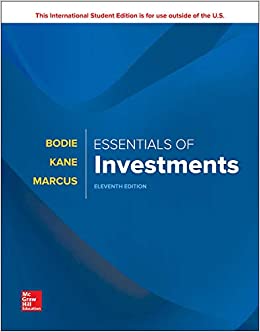Question
1.All else being equal, an increase in the yield to maturity of a bond will result in: a)an increase in the maturity value of the
1.All else being equal, an increase in the yield to maturity of a bond will result in:
a)an increase in the maturity value of the bond.
b)an increase in the market price of the bond.
c)a decrease in the rate of return at which the cash flows from the portfolios can be reinvested.
d)a greater interest rate price risk on a long-term bond than on a short-term bond.
2.The risk-free rate is 5%, the market risk premium is 8%, and the market return is 13%. Stock Y's beta is 1.85 and the standard deviation of its returns is 62.5%. What should be the stock's expected rate of return to make the investor indifferent toward buying or selling the stock?
a)11.66%
b)12.50%
c)15.54%
d)19.80%
3.The beta coefficient of Zed Corporation is equal to 0.7 and the required rate of return on the stock equals 12 percent. If the expected return on the market is 12.5 percent, what is the risk-free rate of return? (Round off the answer to two decimal places.)
a)10.83%
b)8.89%
c)12.25%
d)9.52%
4.Which of the following is true of the change in the weighted average cost of capital of a firm?
a)A decrease in the weighted average cost of the capital increases the value of the firm.
b)Any change in the weighted average cost of capital results in no change in the value of the firm.
c)A decrease in the weighted average cost of the capital increases the cash flow generated by the investments. A decrease in the weighted average cost of the capital decreases the value of the firm.
Step by Step Solution
There are 3 Steps involved in it
Step: 1

Get Instant Access to Expert-Tailored Solutions
See step-by-step solutions with expert insights and AI powered tools for academic success
Step: 2

Step: 3

Ace Your Homework with AI
Get the answers you need in no time with our AI-driven, step-by-step assistance
Get Started


